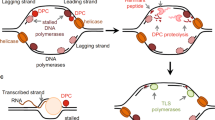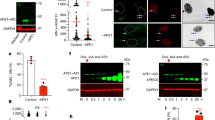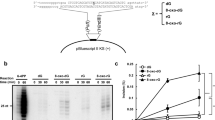Abstract
APURINIC sites in cellular DNA may occur secondary to the slow hydrolysis of purines in physiological conditions1 or the rapid hydrolysis of alkylated purines2. Endonucleases which incise double-stranded DNA at apurinic sites have been purified from E. coli3, calf thymus4 and rat liver5. It has been proposed that such endonucleases hydrolyse the apurinic site as the first step of a repair process similar to excision-repair of ultraviolet photoproducts6. Lindahl and Nyberg calculated that spontaneous depurination, if unrepaired in postmitotic cells such as human neurones, would result in the loss of 3% of the total purines during a lifetime1. Such a loss could be sufficient to produce abnormal proteins which appear in ageing cells7. The more rapid depurination of alkylated bases could be related to the mutagenic and carcinogenic properties of alkylating agents8. Therefore, to relate the repair of apurinic sites to the pathogenesis of human disease, we have characterised the properties of apurinic site endonuclease activity in crude extracts of HeLa cells and then measured such activity in WI-38 cells and human skin fibroblasts. We then compared enzyme activity in skin fibroblasts from individuals with two diseases in which repair of apurinic sites might be defective—progeria, characterised by premature ageing9 and associated with abnormal thermolability of cellular enzymes10, and Fanconi's anaemia, associated with an increased incidence of malignancy and in vitro susceptibility to chromosome breakage by alkylating agents11.
This is a preview of subscription content, access via your institution
Access options
Subscribe to this journal
Receive 51 print issues and online access
$199.00 per year
only $3.90 per issue
Buy this article
- Purchase on Springer Link
- Instant access to full article PDF
Prices may be subject to local taxes which are calculated during checkout
Similar content being viewed by others
References
Lindahl, T., and Nyberg, B., Biochemistry, 11, 3610–3618 (1972).
Brookes, P., and Lawley, P. D., Biochem. J., 89, 138–144 (1963).
Verly, W. G., and Paquette, Y., Can. J. Biochem., 50, 217–224 (1972).
Ljungquist, S., and Lindahl, T., J. biol. Chem., 249, 1530–1535 (1974).
Verly, W. G., and Paquette, Y., Can. J. Biochem., 51, 1003–1009 (1973).
Verly, W. G., Gossard, F., and Crine, P., Proc. natn. Acad. Sci. U.S.A., 71, 2273–2275 (1974).
Orgel, L. E., Nature, 243, 441–445 (1973).
Legator, M. S., and Flamm, W. G., A. Rev. Biochem., 42, 683–708 (1973).
DeBusk, F. L., J. Pediat., 80, 697–724 (1972).
Goldstein, S., and Moerman, E., New Engl. J. Med., 292, 1305–1309 (1975).
Sasaki, M. S., and Tonomura, A., Cancer Res., 33, 1829–1835 (1972).
Lindahl, T., and Andersson, A., Biochemistry, 11, 3618–3623 (1972).
Duker, N. J., and Teebor, G. W., Nature, 255, 82–84 (1975).
Levine, E. M., Meth. Cell Biol., 8, 229–248 (1974).
Brent, T. P., Nature new Biol., 239, 172–173 (1972).
Lowry, O. H., Rosebrough, N. J., Farr, A. L., and Randall, R. J., J. biol. Chem., 193, 265–275 (1951).
Ljungquist, S., Andersson, A., and Lindahl, T., J. biol. Chem., 249, 1536–1540 (1974).
Bacchetti, S., and Benne, R., Biochim. biophys. Acta, 390, 285–297 (1975).
Verly, W. G., Paquette, Y., and Thibodeau, L., Nature new Biol., 244, 67–69 (1973).
Epstein, J., Williams, J. R., and Little, J. B., Biochem. biophys. Res. Commun., 59, 850–857 (1974).
Poon, P. K., O'Brien, R. L., and Parker, J. W., Nature, 250, 223–225 (1974).
Regan, J. D., and Setlow, R. B., Biochem. biophys., Res. Commun., 59, 858–864 (1974).
Braun, A., and Grossman, L., Proc. natn. Acad. Sci. U.S.A., 71, 1838–1842 (1974).
Carrier, W. L., and Setlow, R. E., Analyt. Biochem., 43, 427–432 (1971).
Vinograd, J., Lebowitz, J., Radloff, R., Watson, R., and Laipis, P., Proc. natn. Acad. Sci. U.S.A., 53, 1104–1111 (1965).
Author information
Authors and Affiliations
Rights and permissions
About this article
Cite this article
TEEBOR, G., DUKER, N. Human endonuclease activity for DNA apurinic sites. Nature 258, 544–547 (1975). https://doi.org/10.1038/258544a0
Received:
Accepted:
Issue Date:
DOI: https://doi.org/10.1038/258544a0
This article is cited by
Comments
By submitting a comment you agree to abide by our Terms and Community Guidelines. If you find something abusive or that does not comply with our terms or guidelines please flag it as inappropriate.



